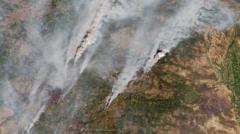Is This the Worst Wildfire Season Ever for the EU?

Published: 2025-08-28 03:21:06 | Category: technology
The wildfire season in the European Union (EU) has reached alarming levels, with a record one million hectares burned, equivalent to about half the land area of Wales. This marks the worst wildfire season since records began in 2006, with Spain and Portugal particularly affected. The intensifying fires have been closely linked to climate change, and experts warn that increasing frequency and severity of wildfires are likely to persist in the future.
Last updated: 26 October 2023 (BST)
Key Takeaways
- Over one million hectares have burned in the EU, the worst season on record.
- Spain and Portugal account for more than two-thirds of the total burnt area.
- The Mediterranean region faces increased wildfire risks due to climate change.
- Firefighting efforts have reached unprecedented levels in response to the crisis.
- Wildfires contribute significantly to greenhouse gas emissions, exacerbating climate change.
Understanding the Scale of Wildfires in Europe
As of August 2023, the European Union has recorded unprecedented wildfires, with more than one million hectares scorched. This figure is staggering, representing a significant increase over previous years. The situation has been particularly dire in Spain and Portugal, where the combined burn area reached 684,000 hectares—four times the area of Greater London. This increase in wildfire activity has raised concerns among scientists and policymakers alike.
Impact on Spain and Portugal
Spain has reported more than 400,000 hectares burned, six times the average for the same timeframe between 2006 and 2024. Portugal is not far behind, with around 270,000 hectares affected, nearly five times the average. The fires have predominantly ravaged forested regions in northern Portugal and north-western Spain, including areas of ecological significance such as the Picos de Europa National Park.
The Role of Climate Change
Research from the World Weather Attribution group at Imperial College London has established a direct link between climate change and the increased frequency of wildfires. The study indicates that human-induced climate change has made conditions conducive to such fires approximately ten times more likely. Notably, the extreme weather events leading to these wildfires have increased by 22% due to climate change impacts.
The Environmental Consequences
The environmental ramifications of these wildfires extend beyond immediate destruction. Smoke from the fires has severely degraded air quality, impacting regions as far away as France and the UK. Moreover, the wildfires have released a record 17.68 million tonnes of CO2 from fires in Spain alone this year, surpassing annual emissions from wildfires recorded since 2003. This poses a significant challenge, as the released CO2 further exacerbates the climate crisis.
Factors Contributing to Wildfire Severity
Several factors have contributed to the severity of the current wildfire season. The ongoing trend of rural depopulation in Southern and Eastern Europe has resulted in abandoned agricultural land, which often becomes overgrown and increases the availability of flammable vegetation. This change has eliminated natural fire breaks, making the landscape more susceptible to intense wildfires.
Ecological Dynamics of Wildfires
While wildfires have historically played a role in Mediterranean ecosystems, the scale and frequency of modern fires present a new challenge. Some species, such as the Iberian hare, may benefit from the habitat changes caused by wildfires. However, the rapid frequency of these fires can exceed the regrowth capacity of vegetation, leading to a detrimental feedback loop that further fuels climate change.
Fire Management Strategies
Effective fire management is crucial in mitigating the risks associated with wildfires. Traditional practices, such as prescribed burning and vegetation management, can help control fire spread. However, as climate conditions become increasingly unpredictable, these methods may need to be adapted or supplemented with new technologies and strategies.
Innovations in Fire Prevention
Advancements in fire detection and suppression techniques are essential in addressing the growing wildfire crisis. Efforts to manage excess vegetation in high-risk areas, coupled with improved firefighting resources, can significantly reduce both the number and severity of future wildfires. The deployment of the EU civil protection mechanism's firefighting force represents a critical step in addressing this crisis.
The Future of Wildfires in Europe
As climate change continues to shape weather patterns, the likelihood of extreme wildfires in Europe is expected to increase. Experts like Dr. Fredi Otto emphasise the urgency of reducing fossil fuel consumption to prevent further exacerbation of climate conditions. Without significant action, Europe may face an ongoing cycle of increasingly severe wildfires, challenging both ecosystems and human communities.
Conclusion
The current wildfire season serves as a stark reminder of the impacts of climate change and the urgent need for comprehensive strategies to manage and mitigate fire risks. As conditions continue to worsen, the integration of innovative fire management practices will be vital. How will we adapt to these changes in our environment, and what measures can we take today to ensure a safer tomorrow?
FAQs
What are the main causes of wildfires in Europe?
The primary causes of wildfires in Europe include climate change, which creates hotter and drier conditions, rural depopulation leading to overgrown vegetation, and human activities such as land management practices and accidental ignitions.
How do wildfires affect air quality?
Wildfires release significant amounts of smoke and pollutants into the atmosphere, leading to decreased air quality. This can cause respiratory issues and other health problems for individuals living in affected areas, sometimes reaching distant regions due to prevailing winds.
What can be done to prevent wildfires in the future?
Preventive measures include effective vegetation management, improved fire detection systems, public awareness campaigns, and investments in firefighting resources. Integrating traditional methods like prescribed burning with modern technology can also enhance fire management efforts.
How does climate change impact the frequency of wildfires?
Climate change leads to increased temperatures and prolonged dry spells, creating conditions that are more conducive to wildfires. These changes in weather patterns make it more likely for vegetation to become dry and flammable, increasing the risk of fires igniting and spreading.
What role do wildfires play in Mediterranean ecosystems?
Wildfires are a natural component of Mediterranean ecosystems, helping to clear old vegetation and create new habitats. However, the increasing frequency and intensity of modern wildfires can disrupt this balance, threatening biodiversity and overall ecosystem stability.



